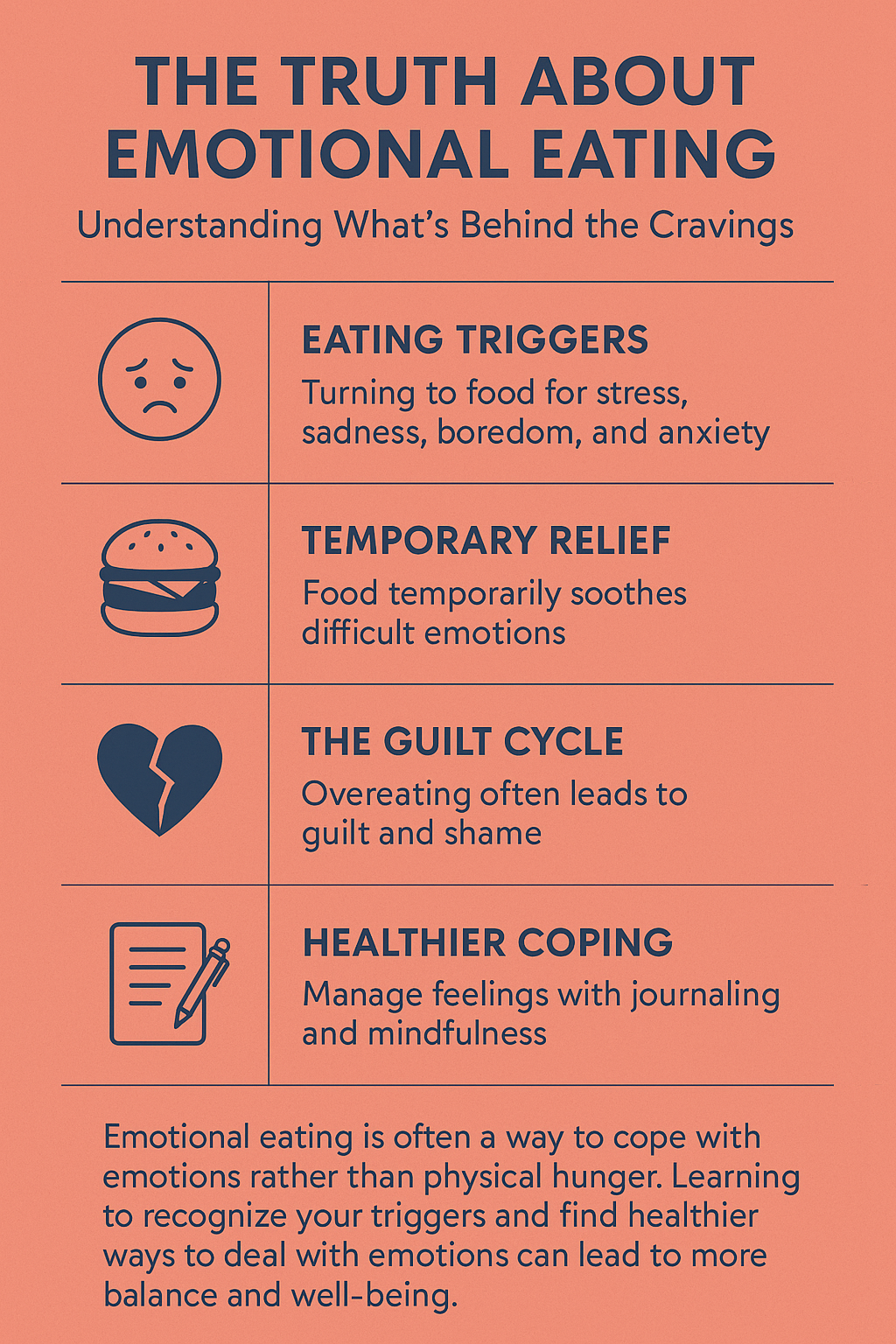Emotional eating is something almost everyone experiences, yet many people don’t realize it’s happening until it becomes a pattern that’s hard to break. It’s more than just reaching for comfort food after a stressful day—emotions can subtly influence your appetite, cravings, and food choices in ways you may not notice at first. Stress, sadness, boredom, loneliness, or even happiness can all steer eating habits, making food feel like a quick solution to emotional discomfort. I’ve seen how easily this cycle forms and how frustrating it can be when it starts affecting health, mood, or self-esteem. This article explores what emotional eating really means, the science behind why it happens, and practical strategies to help you understand your triggers, respond with healthier coping tools, and regain control of your relationship with food.
The Real Story Behind Emotional Eating
Emotional eating isn’t just about grabbing a tub of ice cream after a rough day. It’s actually a way your mind and body try to deal with feelings, including boredom, stress, happiness, or sadness. Using food for comfort is nothing new, as eating triggers the release of feel-good chemicals in your brain, such as dopamine and serotonin.
Work deadlines, family drama, or even happy events can evoke strong emotions. When these emotions build up, reaching for snacks often feels like a quick fix. Food distracts from discomfort in the short term, but it rarely addresses the underlying cause of the feelings.
The idea that emotional eating is just a “weakness” is a pretty common myth. In reality, it’s a learned response; one that often begins at a young age and stems from various sources, such as family traditions or using food as a reward. According to Harvard Health, emotional eating is popular and can affect anyone, regardless of age or lifestyle (source).
How Emotional Eating Starts
Emotional eating doesn’t come out of nowhere. Typically, it begins when someone associates food with relief or comfort. This can happen for lots of reasons, and I’ve seen it sneak up on even the healthiest eaters.
- Childhood Habits: If your family celebrated, grieved, or handled stress with food, it’s easy to keep that pattern going as an adult.
- Busy Lifestyles: When you’re rushed all day, you might not have time to process feelings, so food becomes a substitute for dealing with what’s going on.
- Dieting Cycles: Strict diets can swing the door wide open to emotional eating. Depriving yourself often makes cravings stronger and emotional eating more likely.
Stressful weeks, lonely weekends, or even a big win at work can all become triggers. The brain learns that food brings comfort, and these habits reinforce themselves over time.
How to Tell If You’re Eating Because of Emotions
It’s easy to brush off emotional eating as “just being hungry,” but there are some classic signs that emotions are at play:
- Sneaky Cravings: A sudden urge for a particular food, especially one high in sugar or salt, is a clue.
- Mindless Munching: If you find yourself snacking while scrolling social media or watching TV and barely notice the food disappearing, you might be eating emotionally.
- Eating Past Fullness: Continuing to eat even when you’re not hungry is often a red flag.
- Feeling Guilty Afterward: Guilt or shame after eating a bunch of snacks can signal emotional eating, especially if you weren’t actually hungry to begin with.
Simple Strategies to Break the Cycle
You don’t need a perfect diet or steel self-control to slow down emotional eating. My experience is that a few simple steps make a big difference:
- Notice Your Triggers: Start keeping a journal—jot down what’s happening, how you’re feeling, and what (if anything) you ate. Tracking helps spot emotional patterns.
- Pause Before Eating: When you feel the urge to snack, wait 5 minutes before eating. Check in with yourself: are you actually hungry, or are you just bored, sad, or stressed? Sometimes just taking a pause helps you figure things out.
- Swap Comfort Strategies: Have a go-to feel-good activity on hand. Take a walk around the block, call a friend, or listen to your favorite playlist. Anything that helps you ride out feelings without reaching for the kitchen is worth a try.
- Build an Emergency Food List: Stock up on foods you like, but avoid those that trigger bingeing. Fresh fruit, popcorn, or yogurt works for some people.
No one gets this perfect every time. The most helpful thing I’ve learned is to be curious rather than judgmental. Messing up now and then is normal; it’s about understanding what works for you over time.
Things to Keep in Mind About Emotional Eating
There’s no single answer to emotional eating, but understanding what’s going on helps a lot. Here are a few things to think about if you want to ease the grip of emotional eating:
- Restrictive Dieting: Diets that cut out all your favorite foods can actually trigger emotional eating. Enjoying treats in moderation is generally more beneficial for most people.
- Support Networks: Friends, family, or online groups can provide a sounding board when you’re tempted to eat your feelings.
- Stress Management Tools: Activities like walking, yoga, journaling, or even deep breathing can help manage feelings in healthier ways.
- Medical Conditions: Certain health issues, like thyroid disorders or depression, can play a role in appetite and cravings. Sometimes it’s worth checking in with a doctor or therapist if emotional eating feels out of control.
What If Emotional Eating Won’t Go Away?
For some people, emotional eating gets tangled up with tough stuff like eating disorders or depression. If it feels overwhelming or is interfering with your daily life, seeking professional help is a wise decision. Many therapists and nutritionists are familiar with emotional eating and can offer personalized advice or support. Therapy, especially cognitive-behavioral therapy (CBT), has a good record of helping people understand and manage emotional eating.
Is Emotional Eating Always Bad?
Sometimes food is a comfort, and that’s okay. There’s nothing wrong with sharing cookies with friends after a hard day or having a bowl of popcorn with a movie. Food can be part of tradition, culture, and celebration. The trick is paying attention. If emotional eating happens every once in a while and isn’t getting in the way of your life, it’s usually not a problem.
How Emotional Eating Shows Up in Real Life
I’ve met plenty of people who’ve faced emotional eating in different ways. For example, my friend Sam always found himself at the fridge late at night after stressful workdays. He started making a list of things he could try instead, such as stretching or doodling for ten minutes, and found that sometimes the snack urge faded away.
- Office Stress: Many people snack at their desks without much thought while tackling big projects. Keeping healthy snacks around and taking short breaks outdoors helped a lot with this.
- Lifestyle Shifts: One woman I know realized her emotional eating had picked up after she had kids and found herself more isolated. She started calling friends in the evening or planning mini self-care routines to break the habit.
If any of these examples sound familiar, you’re not alone. Emotional eating is something countless people handle every day, and everyone’s story looks a little different. Sometimes, just talking to others who understand can make the process of making changes feel less daunting.
Frequently Asked Questions
Here are some questions I get all the time about emotional eating:
Question: How do I know if I’m emotionally eating or just hungry?
Answer: Usually, emotional hunger comes on suddenly and latches on to specific cravings. Physical hunger builds gradually and isn’t picky; almost any food will do. Checking in with your emotions and hunger cues helps here.
Question: Are there quick fixes for emotional eating?
Answer: There’s no magic pill, but journaling, pausing before eating, and finding a support system go a long way. Habits take time to shift, but small steps add up.
Question: Can emotional eating cause health problems?
Answer: If it’s constant and leads to eating way more than your body needs, some health issues like weight gain or blood sugar swings can show up. Not everyone who emotionally eats will have these problems, but it’s something to watch if you notice side effects.
Question: What are some signs that I need more help with emotional eating?
Answer: If emotional eating starts to feel out of control or you feel anxious, depressed, or isolated, it’s time to reach out for support. Professionals can provide you with practical tips or offer more in-depth assistance if needed.
Is It Possible to Say Goodbye to Emotional Eating?
Changing how you relate to food takes time, patience, and a bit of self-compassion. Anyone can make progress, even if it’s just learning to distinguish between real hunger and a tough day. With honest reflection, open support, and a few practical strategies, you can manage emotional eating more effectively and regain control over your eating habits.
No need to go it alone. Whether it’s talking with friends, checking in with a counselor, or simply slowing down and listening to your body, every little step helps. Making even minor tweaks in how you react to your emotions and food can add up to a fundamental shift over time. Remember, it’s about progress, not perfection; each step counts on the path to a more balanced relationship with food.
Video: Why Do We Eat When We’re Sad?

